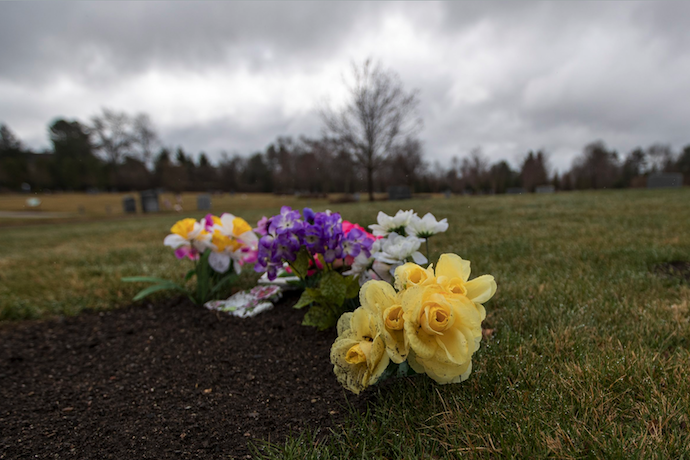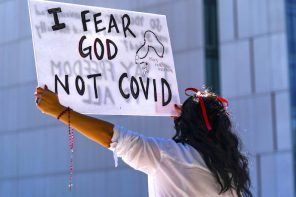In May, when the US hit 90,000 Covid-19 related deaths, the Washington Post, published a piece decrying the lack of public mourning from the President and his administration. When we reached 170,000 Covid-19 related deaths, CNN published a similar call. As Americans, some of us have been touched by death personally during the pandemic, but for many more of us, Covid-19 deaths are abstract and impersonal. This is what made Kristin Urquiza’s voice so powerful during the opening night of the Democratic National Convention as she described her father, a Trump voter, whose “only preexisting condition was voting for Trump.”
Hovering over the pageantry of the convention was the fog of death and a deep anxiety that we, as Americans, may not be able to muster the collective will to tackle this challenge. But it also offered one of the most widespread moments of collective, public mourning, which can serve as a catalyst for taking the pandemic seriously.
In my own life, Covid-19-related death has been absent. It was only recently, when a former student died in a tragic accident, that I realized how removed death has been from my experience. He was the son of friends; his mother is the head of my children’s school. The death of a young person, especially one with exceptional promise, would be a tragedy on any day. Given the grim backdrop of the pandemic it felt especially cruel. Our community is devastated. My wife and I have found ourselves regularly dissolving into tears. The death has unleashed four months of loss.
We learned of his death midday on a Monday and by that afternoon our community was gathered on Zoom—over 250 tiny boxes of grief—many from our synagogue, but many streaming in from around the world. Despite its ability to transcend geographic boundaries, Zoom offers little comfort. We couldn’t embrace or offer each other solace. It’s hard to have a sense of the collective when you have to scroll through pages of faces. My rabbi, a master at building community, asked us all to unmute and listen to each other’s pain. Grief-stricken, we sat as different viewers’ breathing or sobs broke in randomly over others.
Until news of my former student’s death, Covid-19 had been an extreme inconvenience. I was frustrated from having to look after my young children while trying to work throughout the spring. I was disappointed that my son, a rising kindergartener, would miss out on important social and emotional development milestones in the fall. As a Bay Area resident, I’ve been sheltering-in-place since early March. It’s been annoying and depressing, but we’re incredibly fortunate. Death and mortality—even unemployment—have been absent from our Covid-19 experience.
Mourning activities offer us access to each other’s pain and lead us to reflect on the need to alleviate suffering more broadly. As we moved into the formal mourning period, the social distance barriers to performing these rituals only served to amplify our distance from one another and minimize their effects.
This was especially challenging for an encumbered, tight knit, Orthodox Jewish community like ours. These rituals are intentionally procedural. In the face of loss, discomfort, and confusion, the ritual act provides a structure to navigate our surroundings. In Ritual and Its Consequences: An Essay on the Limits of Sincerity Adam Seligman, Robert Weller, Michael Puett and Bennett Simon identify that ritual, in its rote doing, allows for dissonance and contradiction. Ritual, they explain, creates an “as-if” subjunctive of the world that could be. But in ritual’s repetition one becomes comfortable with the gap between the attempts of ritual and the reality of the world.
Of course, during the pandemic, we’re unable to perform these rituals as usual. There’s a lack of dignity to all aspects of this new COVID reality—even the darkest most formal moments of grief. While the Zoom memorial service allowed upwards of 1,000 people to participate from around the globe—including one speaker, a well-known head of an Israeli Yeshiva and another, the deceased’s roommate, an observant Muslim now back home in Karachi—for us, the sanctity was punctured by my children running in to ask for lunch and the sounds of the neighbor mowing his lawn.
The shiva, the seven-day period when mourners sit (in chairs low to the ground) and receive visitors, was limited to family and a select group of friends. Visits were pre-scheduled, 25-minute slots for one or two family units at a time. Shiva is about showing up and being there, more than doing something. The interaction is scripted. One isn’t supposed to offer a greeting to either the mourner or fellow visitors, you should not speak to them until spoken to, just be there as a comforting presence. Upon departing, one bids farewell with a scripted line in Hebrew, “May the Omnipresent comfort you among the rest of the mourners of Zion and Jerusalem.”
Shiva in this new reality, demands what Seligman et al identify as sincerity, which tries to close that gap of ritual towards some notion of “authenticity.” They write:
Sincerity often grows out of reaction against ritual. It criticizes ritual’s acceptance of social convention as mere action (perhaps even just acting) without intent, as performer without belief… The sincere mode of behavior seeks to replace the “mere convention” of ritual with a genuine and thoughtful state of internal conviction.
When available, sincerity allows us to express ourselves in meaningful ways. But sincerity requires authentic emotion, something that’s only possible when one really means it. Shiva provides the space for dissonance when one can sit in the company of friends and strangers, and just continue to be, through the lulls of conversation, anguish, and pain. Gathering provides much needed collective quiet and non-verbal interactions. The moments of connection born out of boredom and awkward silence.
When acts of mourning are filtered through Zoom or bounded by a tight schedule, the comforts of ritual wither and we’re rushed to transform the experience into a sincere moment. Shiva and other scripted mourning rituals allow those who aren’t sad, who may not have a direct connection to the deceased, to be drawn into the communal project of mourning as social beings.
Through these experiences, behaviors of social connectivity emerge which strive to alleviate suffering. Around the mourners a network of informal helpers feed people, take care of children and make sure that, even while dealing with death, life can go on. These activities draw the community into the mourning process, reverberating through the layers of connection, helping to ritualize a commitment to human dignity.
Maimonides, the great 12th century legalist and philosopher, understood accompanying the dead and comforting mourners as embodied practices which manifest the Biblical command to love the other as yourself (Mishna Torah, Laws of Mourning 14:1). It’s through these rituals that one communicates dignity and the value of life. It’s through these activities that the community, individually and collectively, engages in catharsis that can lead to societal transformation.
In encountering this lone, accidental death, I realized how protected I’ve been from our national tragedy. Our inability to mourn together isn’t just emotionally challenging but reflects the larger political challenge of this moment. The absence of death in real, visible public ways, with ongoing public mourning is a central cause in the lack of collective commitment to defeat the virus. Our lack of collective mourning reflects a broader disengagement from death throughout the pandemic.
The number of deaths is a rolling tab, a new national debt, scrolling at the bottom of the TV screen. There are no funeral marches, no mass services at cemeteries. The images and sounds of death are absent from our news media. It’s too dangerous for a camera crew to enter an ICU ward. How might the airing of choking, coughing and strained breathing, like war footage, change our national discourse?
Three weeks later, my community is still numb. When I run into a friend on the street, we break into tears; the loss is still palpable. But the pain has only dulled because we’re not able to be in the places where we lived with this young man and his family. It will be quite some time before I get to see his father standing in his normal spot again in our synagogue sanctuary. I’m not able to inhabit a public life that offers regular reminders of his absence. We’re not actually coming to grips with the loss, it’s simply out of sight.
And this is a single reflection of our national existence. There are now over 150,000 families, developing networks of pain and suffering wrought by this national tragedy and this administration’s indifference.
During a presidency defined by border walls, travel bans, and caged children are we surprised that we’ve ended up confined to our homes, disembodied faces in Zoom memorial services? We desperately need mechanisms for public mourning, for our collective grief, so that we may take seriously the deep challenges our country faces.





